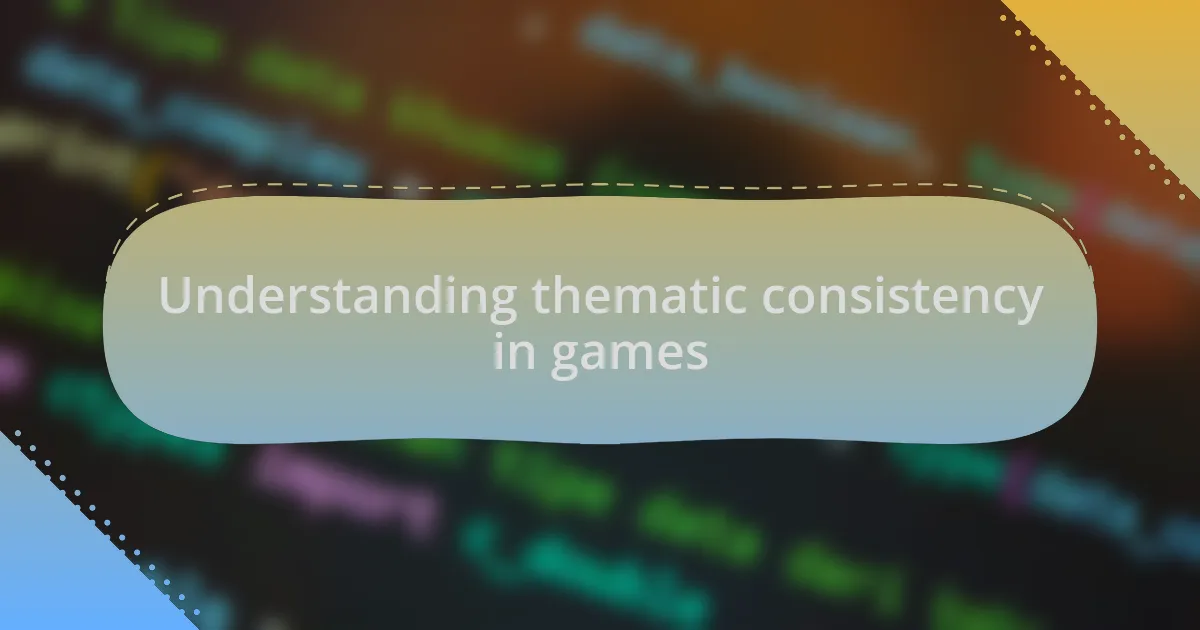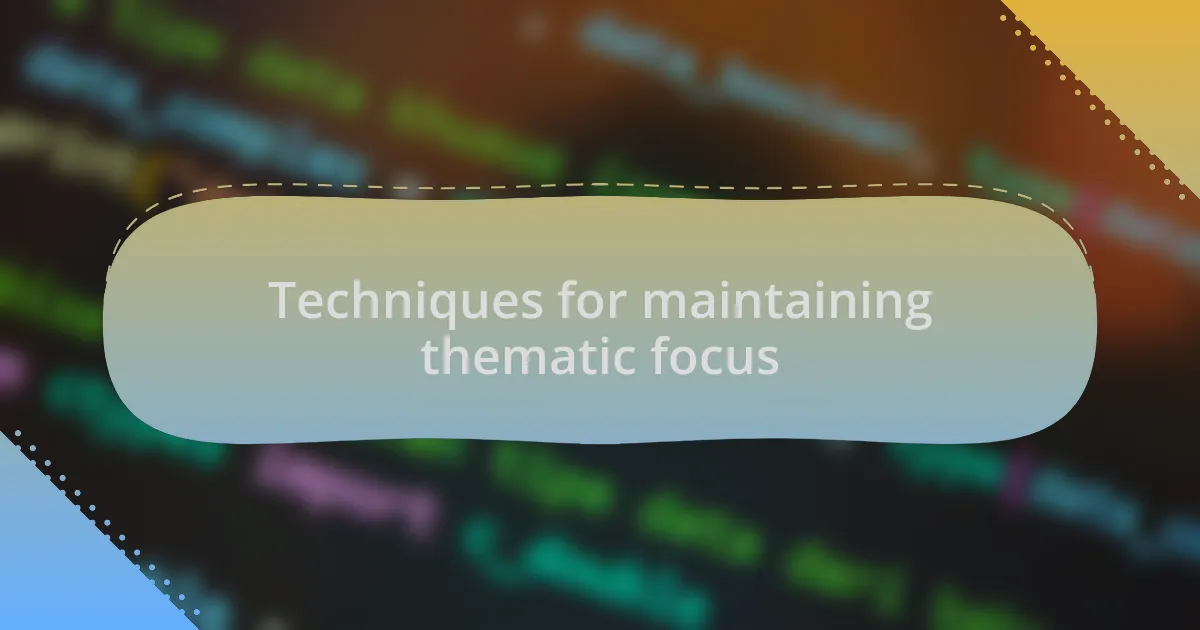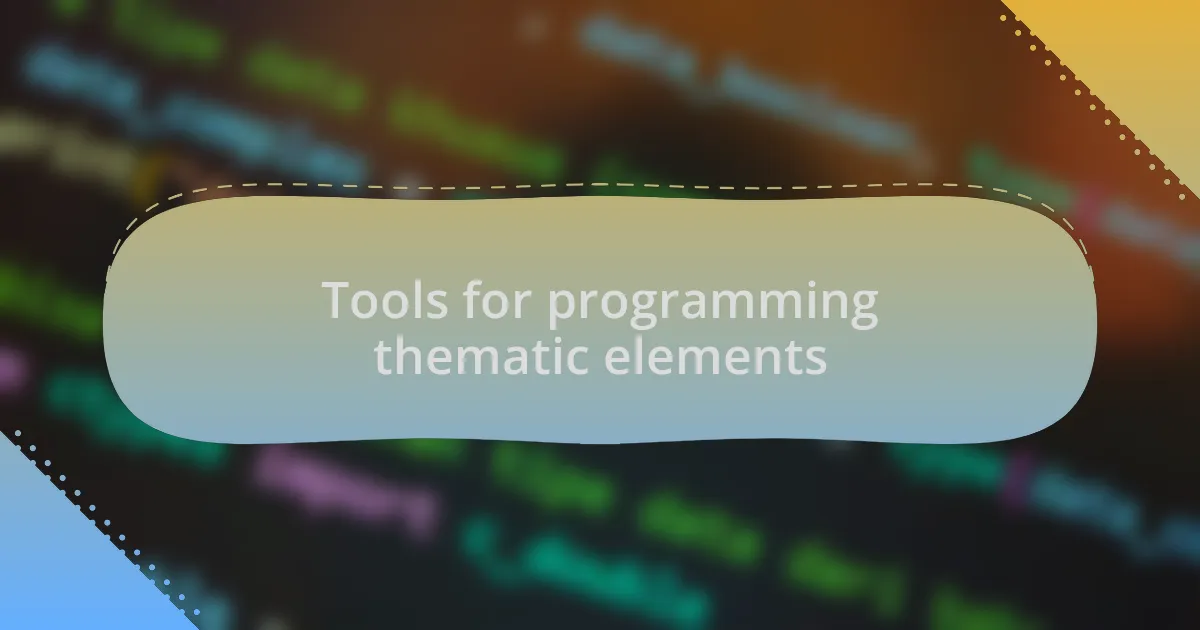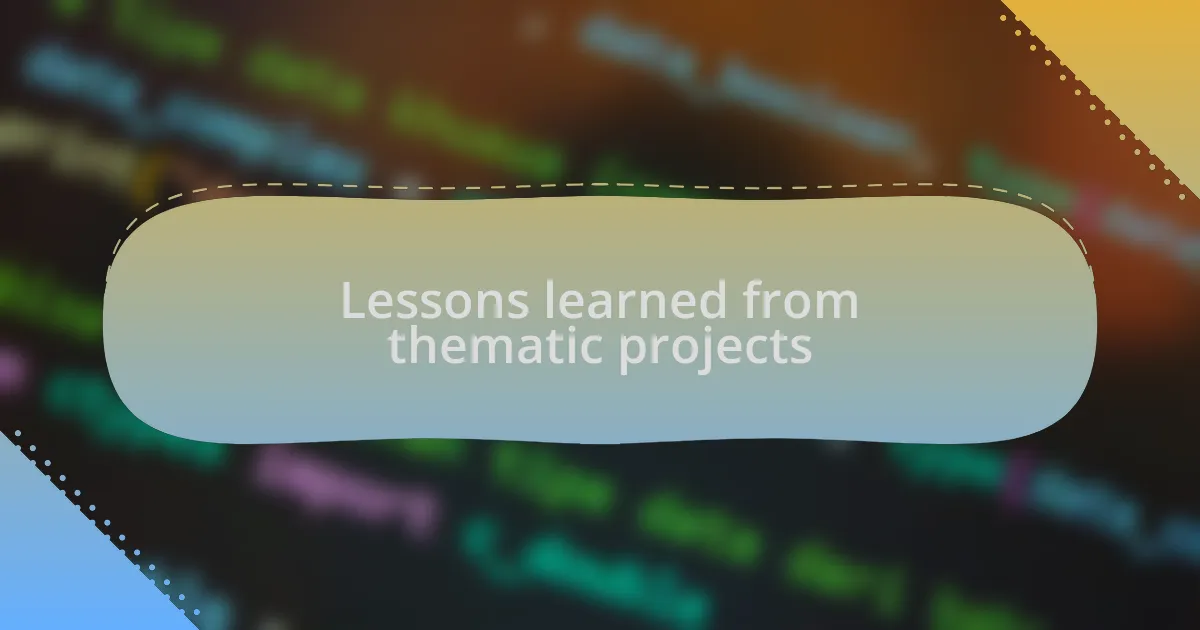Key takeaways:
- Thematic consistency enhances player immersion by aligning game mechanics, visuals, and audio with the overarching narrative.
- Utilizing tools like game engines, sound design software, and consistent art direction can significantly improve the integration of thematic elements.
- Player decisions that reflect the theme create deeper engagement and emotional investment in the game’s storyline and characters.

Understanding thematic consistency in games
Thematic consistency in games goes beyond mere aesthetics; it shapes the entire player experience. Think about your favorite game—how does its theme resonate with its mechanics? For instance, in a dystopian narrative, not only should the visuals reflect that bleak reality, but the gameplay should also reinforce feelings of survival and resistance.
When I was working on a game project based on medieval folklore, I found that every element—the art, sound, and even the dialogue—had to reflect that thematic core. It was a thrill to see players immerse themselves in a world where even the smallest details, like the choice of weaponry or the design of non-playable characters, echoed the rich tapestry of the theme. This alignment can evoke powerful emotions, creating an engaging experience that players relate to on a personal level.
Have you ever played a game that felt disjointed in its approach to theme? It can be jarring when the narrative and gameplay don’t match. For example, if a game about harmony and cooperation suddenly throws in chaotic mechanics, it diminishes the player’s connection to the experience. This is why I believe that maintaining thematic consistency is crucial for fostering deeper engagement and emotional investment in any game.

Techniques for maintaining thematic focus
Developing a cohesive atmosphere in a game often requires a careful selection of mechanics that resonate with the theme. I remember when designing a fantasy adventure, I incorporated magic not just as a flashy ability, but also as a tool for problem-solving and overcoming obstacles. This approach reinforced the idea that magic is an integral part of the world and not just a superficial layer, enhancing the player’s connection to the narrative.
Another technique I often rely on is creating a consistent audio landscape that complements the visuals and gameplay. During my last project, I chose ambient sounds and music that mirrored the tension of a post-apocalyptic setting. The haunting melodies shaped the player’s emotional response, heightening their immersion and making them feel the weight of their choices in that bleak environment. Have you ever noticed how a simple sound can transport you deeper into a game’s narrative?
Lastly, it’s vital to continuously reflect the theme in player decisions. I once facilitated a game where players had to make morally complex choices, allowing them to shape the storyline. Feedback from playtesters revealed that these decisions not only influenced the plot but also created an emotional investment in the characters’ fates. Asking players to reflect on their choices deepens their engagement and keeps the theme front and center, creating a memorable experience.

Tools for programming thematic elements
Choosing the right tools to program thematic elements can significantly enhance a game’s immersive experience. For instance, I often use game engines like Unity or Unreal Engine, which allow for detailed customization of environments, characters, and interactions. When I developed a sci-fi game, the ability to script dynamic events really made the alien world feel alive—I could create weather effects and spontaneous character behaviors that aligned perfectly with the theme. Have you ever walked through a digital landscape and felt like it was breathing around you?
In addition to engines, I also lean on libraries and frameworks like Phaser for 2D games. The ease of integrating thematic assets—like character sprites that reflect the lore of a world—has been invaluable in projects I’ve worked on. I vividly recall a project where every sprite was meticulously chosen not just for aesthetic value but to tell a piece of the overall story. It’s amazing how coherent visuals can tighten a narrative and make players feel like they are part of the unfolding drama.
Lastly, I find that utilizing sound design tools, such as FMOD or Wwise, is crucial for programming thematic audio elements. I remember working on a horror-themed game where I adjusted audio cues to reflect the players’ actions and decisions. The tension became palpable with each footstep they took, deepening the sense of dread. Don’t you think the right sound can make your heart race, drawing you further into the experience?

Creating a cohesive gameplay experience
Creating a cohesive gameplay experience hinges on ensuring that all elements resonate with the desired theme. I remember working on a fantasy RPG where I meticulously designed quests to reflect not only the narrative but also the underlying philosophies of the world. Each quest felt like a chapter in a larger story, compelling players to immerse themselves more deeply. Have you ever felt like your choices carried weight in a game? That’s the kind of engagement I strive for.
Visual consistency is another crucial aspect I focus on. In one of my indie projects, I decided to unify the color palette across scenes, which tied everything together beautifully. Players commented on how the art style made them feel as if they’d stepped into a painting. It’s fascinating how something as simple as a consistent color scheme can evoke emotions and enhance storytelling.
Finally, I believe gameplay mechanics should serve the theme and narrative cohesively. During a space exploration game I developed, we introduced gravity-based mechanics that reflected the character’s struggles. When players navigated through zero gravity zones, it not only elevated the gameplay but also deepened their emotional connection to the protagonist’s journey. Isn’t it interesting how mechanics can amplify storytelling and make every moment feel significant?

Personal experiences with thematic consistency
One of my standout experiences with thematic consistency came while developing a horror game. I remember vividly how I crafted the atmosphere by layering unsettling audio cues and dim lighting to match the game’s eerie narrative. Those details not only set the mood but also heightened players’ feelings of vulnerability, pulling them into a world where every sound echoed their fears. Have you ever been so immersed that you forgot you were just playing a game? That’s the effect I aimed for.
In another instance, while working on a medieval strategy game, I synchronized the art, story, and gameplay mechanics around the concept of resource scarcity. I vividly recall playtesting a level where players had to manage limited supplies, leading to tense decisions. It was satisfying to see how this theme influenced strategic thinking and created a feeling of urgency. Isn’t it fascinating how a thematic focus can turn simple gameplay into a compelling narrative experience?
Even in smaller projects, I found thematic consistency can shine through subtly. I remember developing an educational game where the vibrant visuals reflected the diverse cultures of the subjects we were teaching. I rolled my eyes in delight when a player expressed how much they learned by exploring different cultures. Moments like that reinforce my belief that when every element aligns with the theme, it creates a lasting impact on players’ experiences.

Lessons learned from thematic projects
There was a project where I delved into designing a space exploration game. The thematic consistency emerged beautifully when I integrated the narrative of isolation with gameplay mechanics that limited resources and communication. I still recall the intensity of a moment when a player, facing dire circumstances, called a friend for help, resembling a real-life survival scenario. Isn’t it incredible how a well-tuned theme can drive players to seek solutions beyond the game itself?
Another lesson I learned came from a collaborative project where we crafted a fantasy RPG. Each character’s abilities and backstories were intricately tied to the magical world we built. As I observed players forming bonds with these characters, it struck me—when the theme resonates throughout every layer of gameplay, it cultivates emotional investment. Have you ever felt a connection so strong that you cheered for a character’s success as if they were a friend?
Finally, I worked on a puzzle game that revolved around time travel. The challenge was ensuring that each puzzle felt era-appropriate while still pushing the overarching narrative forward. There was one particularly engaging moment where a player had to solve a riddle to unlock a portal back to the past. The delight on their face when they realized how the puzzle’s solution tied into the storyline was undeniably gratifying. This experience taught me that, through thematic coherence, puzzles can transcend mere challenges and transform into integral pieces of a larger narrative tapestry.